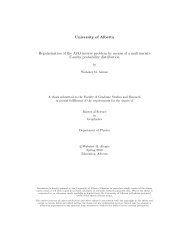Soner Bekleric Title of Thesis: Nonlinear Prediction via Volterra Ser
Soner Bekleric Title of Thesis: Nonlinear Prediction via Volterra Ser
Soner Bekleric Title of Thesis: Nonlinear Prediction via Volterra Ser
You also want an ePaper? Increase the reach of your titles
YUMPU automatically turns print PDFs into web optimized ePapers that Google loves.
4.5. SYNTHETIC AND REAL DATA EXAMPLES 64<br />
prediction <strong>of</strong> data using a third-order <strong>Volterra</strong> series with parameters p = 3, q = 3,<br />
and r = 3. Figure 4.12(c) shows the error between the observed data and predicted<br />
data <strong>via</strong> a third-order <strong>Volterra</strong> series. Figures 4.12(d) and 4.13(b) depict predictions<br />
<strong>of</strong> the data using linear prediction theory with parameter p = 3. In Figures 4.12(e)<br />
and 4.13(c) I portray the difference between original data and predicted data using<br />
the linear prediction method. Figure 4.13(d) illustrates the prediction <strong>of</strong> data using<br />
the cubic part <strong>of</strong> a <strong>Volterra</strong> series with parameter r = 3. Figure 4.13(e) shows<br />
the error between original data and predicted data using only the cubic part <strong>of</strong> a<br />
<strong>Volterra</strong> series. The cubic part <strong>of</strong> a <strong>Volterra</strong> series yields a prediction similar to the<br />
linear prediction theory. In Figure 4.14 I portray the individual contributions <strong>of</strong> a<br />
<strong>Volterra</strong> series to the prediction <strong>of</strong> data. The contribution due to the linear terms <strong>of</strong><br />
the <strong>Volterra</strong> series to the predicted data in Figure 4.14(b) is shown in Figure 4.14(c).<br />
It can be seen that the data are predicted mostly with linear terms. Figures 4.14(d)<br />
and 4.14(e) show the parts <strong>of</strong> the prediction associated with the quadratic (q = 3)<br />
and cubic (r = 3) terms in a third-order <strong>Volterra</strong> series. The contribution <strong>of</strong> the<br />
quadratic part is negligible to the prediction <strong>of</strong> the data; the contribution <strong>of</strong> the<br />
cubic part is relatively better than the quadratic part. Figure 4.14(f) shows the<br />
contribution <strong>of</strong> nonlinear terms associated with quadratic and cubic terms (q = 3<br />
and r = 3). These examples confirm that waveforms with linear moveouts can be<br />
predicted using linear prediction theory and cubic <strong>Volterra</strong> prediction.<br />
Figures 4.15(a) and 4.16(a) show a 2-D synthetic data example with hyperbolic<br />
events. These events have been synthesized using a forward apex-shifted hyperbolic<br />
Radon transform (Hargreaves et al., 2003; Trad, 2003). In Figure 4.15 a comparison<br />
between linear prediction theory and the third-order <strong>Volterra</strong> series is illustrated.









